
Concept explainers
(a)
Interpretation: The most stable radical that can result from cleavage of
Concept introduction: A free radical is an atom or ion with unpaired electrons. They are reactive intermediates formed by the homolysis of covalent bond. Free radicals are classified as
Answer to Problem 15.2P
The most stable radical that can result from cleavage of
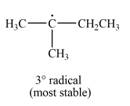
Explanation of Solution
The given species is,
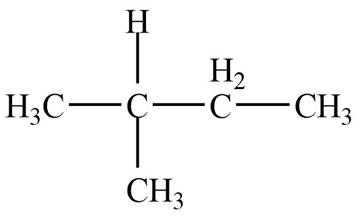
Figure 1
Three types of radicals can be formed by the cleavage of

Figure 2
The number of alkyl substitutents increases, the stability of radical increases. The order of stability is
The most stable radical that can result from cleavage of
(b)
Interpretation: The most stable radical that can result from cleavage of
Concept introduction: A free radical is an atom or ion with unpaired electrons. They are reactive intermediates formed by the homolysis of covalent bond. Free radicals are classified as
Answer to Problem 15.2P
The most stable radical that can result from cleavage of

Explanation of Solution
The given species is,
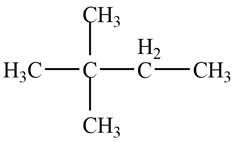
Figure 3
Two types of radicals can be formed from cleavage of

Figure 4
The number of alkyl substitutents increases, the stability of radical increases. The order of stability is
The most stable radical that can result from cleavage of
(c)
Interpretation: The most stable radical that can result from cleavage of
Concept introduction: A free radical is an atom or ion with unpaired electrons. They are reactive intermediates formed by the homolysis of covalent bond. Free radicals are classified as
Answer to Problem 15.2P
The most stable radical that can results from the cleavage of
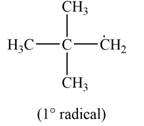
Explanation of Solution
The given species is,
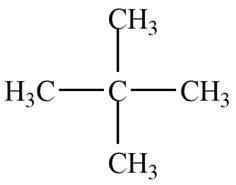
Figure 5
Only

Figure 6
The most stable radical that can result from cleavage of
(d)
Interpretation: The most stable radical that can result from cleavage of
Concept introduction: A free radical is an atom or ion with unpaired electrons. They are reactive intermediates formed by the homolysis of covalent bond. Free radicals are classified as
Answer to Problem 15.2P
The most stable radical that can result from cleavage of

Explanation of Solution
The given species is,

Figure 7
Two types of radicals can be formed from cleavage of
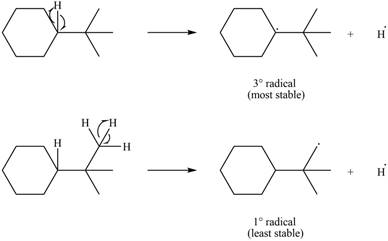
Figure 8
The number of alkyl substitutents increases, the stability of radical increases. The order of stability is
The most stable radical that can result from cleavage of
Want to see more full solutions like this?
Chapter 15 Solutions
Organic Chemistry
- Explain the General Features of Radical Reactions ?arrow_forwardResveratrol is an antioxidant found in the skin of red grapes. Its anticancer, anti-inammatory, and various cardiovascular effects are under active investigation. (a) Draw all resonance structures for the radical that results from homolysis of the OH bond shown in red. (b) Explain why homolysis of this OH bond is preferred to homolysis of either OH bond in the other benzene ring.arrow_forwardChemistry Glutathione (or GSH) can form a disulfide bridge with another glutathione molecule via radical reaction. Show a mechanism of a hydroxide radical reacting with two glutathione molecules to a produce a dimer (GSSG).arrow_forward
- 1 example for organic rearrangement reaction show: a. the overall reaction (reactants --> products) b. the reaction mechanism (indicate intermediate product) c. indicate which is the reactive species or intermediate in the reaction (radical? electrophile? nucleophile?) d. overall description of the reaction eg., radical substitution or SRarrow_forwardWhy is less energy required to break a C-H bond to form a more highly substituted radical? Can somebody summarize the words on this page to make it more understandable?arrow_forward1 example of reaction for each of the types of organic reactions: substitution, elimination, addition, and rearrangement. Show:a. the overall reaction (reactants --> products)b. the reaction mechanism (indicate intermediate product)c. indicate which is the reactive species or intermediate in the reaction (radical? electrophile? nucleophile?)d. overall description of the reaction eg., radical substitution or SRarrow_forward
- Homolysis of the indicated C–H bond in propene forms a resonancestabilized radical. a.Draw the two possible resonance structures for this radical. b.Use half-headed curved arrows to illustrate how one resonance structure can be converted to the other. c. Draw a structure for the resonance hybrid.arrow_forwardwhat is most stable radical that could form from 2,2-dimethylpropane? pls illustratearrow_forwardDraw the structure of either vitamin C or vitamin E and show how they interact with a radical species. Explain briefly why they are good antioxidants.arrow_forward
- Radicals in some instances can lead to undesired reactions foods are known to cause radical Inhibitors known as preservatives or antioxidants these Species Act by preventing radical chain reactions that can lead to degradation of packaged food. One synthetic preservative used commonly in both the food industry and the chemical industry is BHT. Draw the propagation of steps for the reaction of BIT with an all my radical.arrow_forwardDraw the electron-pushing mechanism for the propagation steps of the allylic bromination reactions below. You may omit NBS in your mechanism, and use Br and Br2.arrow_forwardResveratrol is an antioxidant found in the skin of red grapes. Its anticancer, anti-inflammatory, and various cardiovascular effects are under active investigation. (a) Draw all resonance structures for the radical that results from homolysis of the OH bond shown in red. (b) Explain why homolysis of this OH bond is preferred to homolysis of either OH bond in the other benzene ring.arrow_forward


 Organic Chemistry: A Guided InquiryChemistryISBN:9780618974122Author:Andrei StraumanisPublisher:Cengage Learning
Organic Chemistry: A Guided InquiryChemistryISBN:9780618974122Author:Andrei StraumanisPublisher:Cengage Learning


